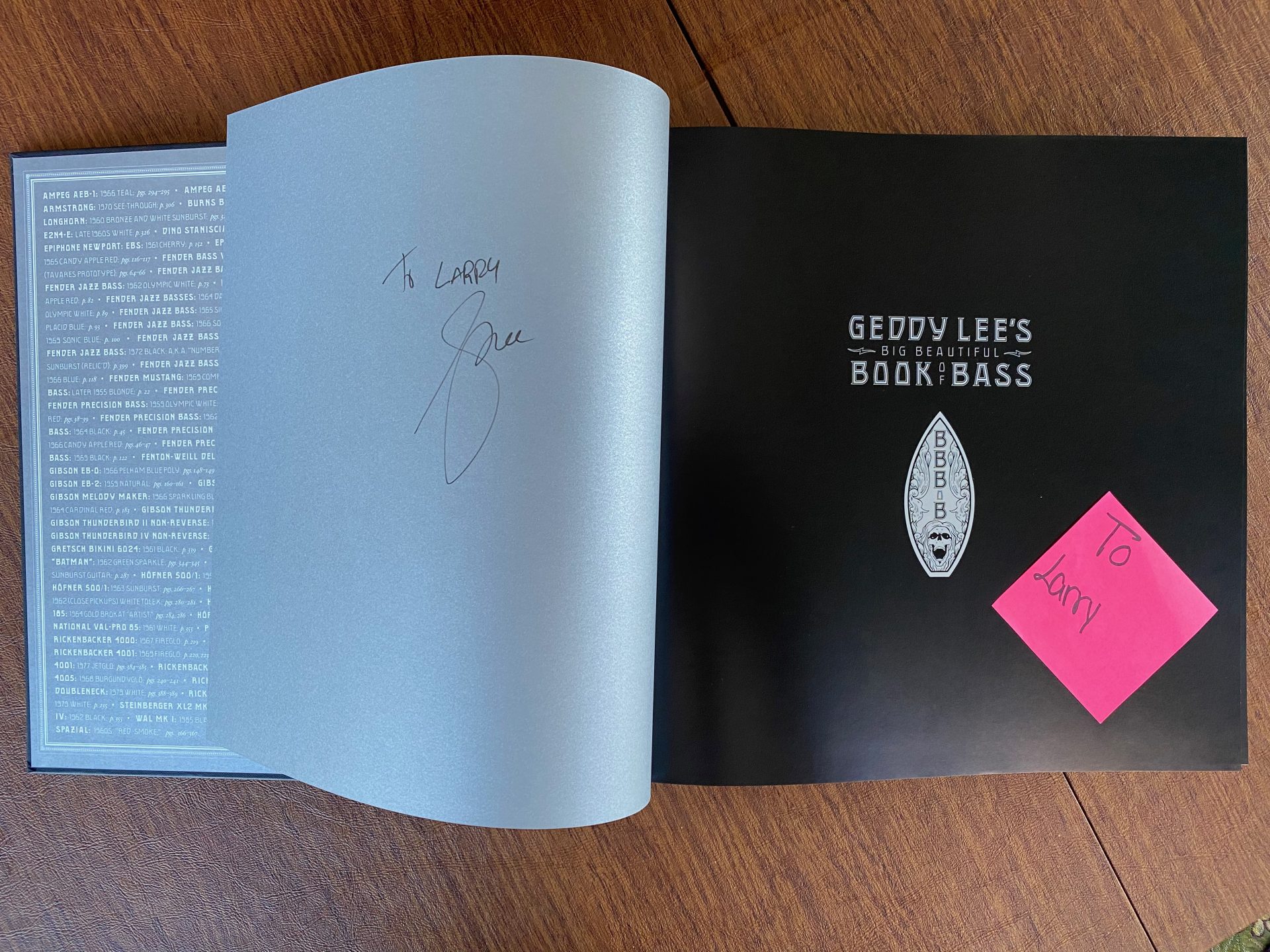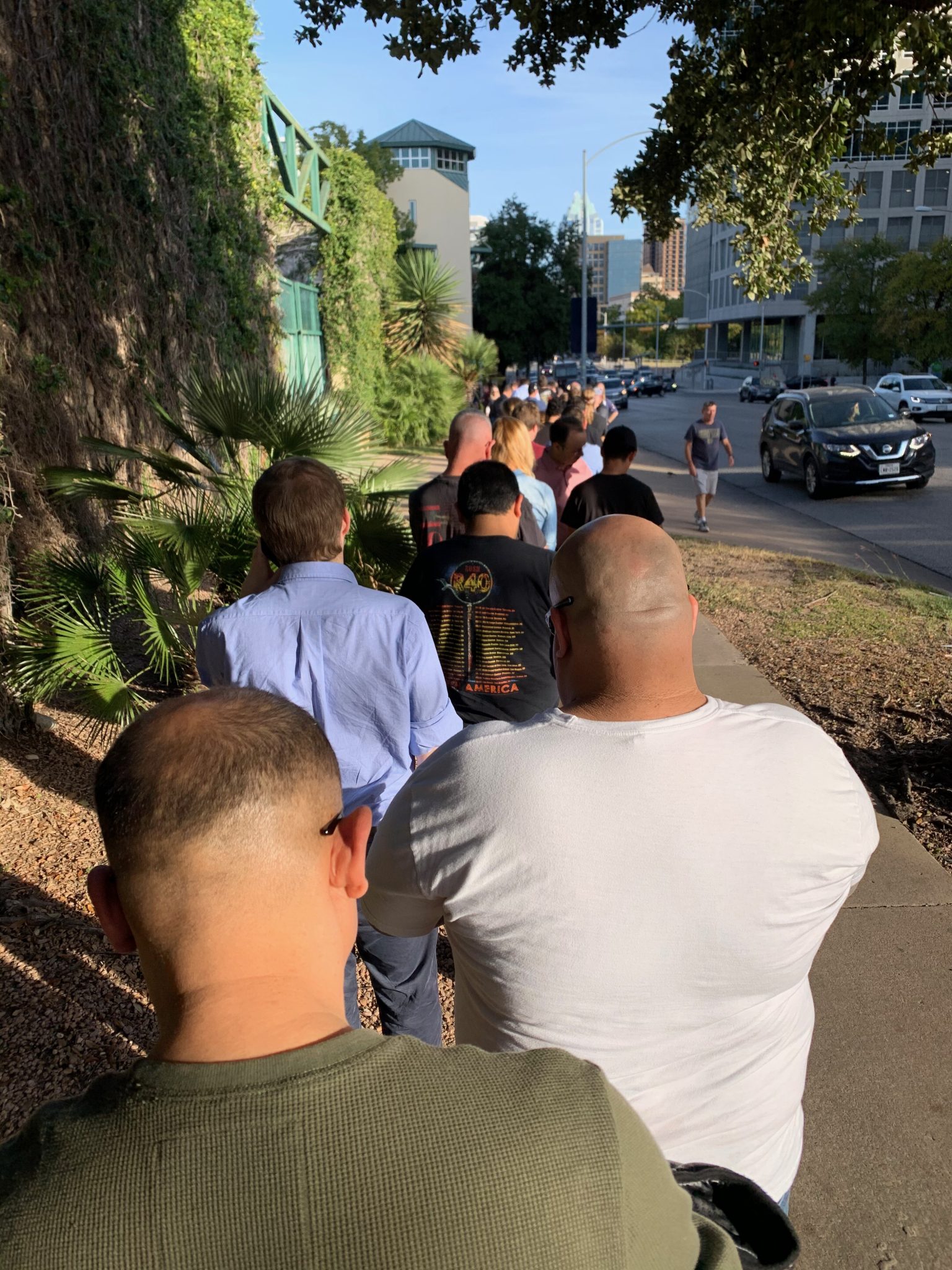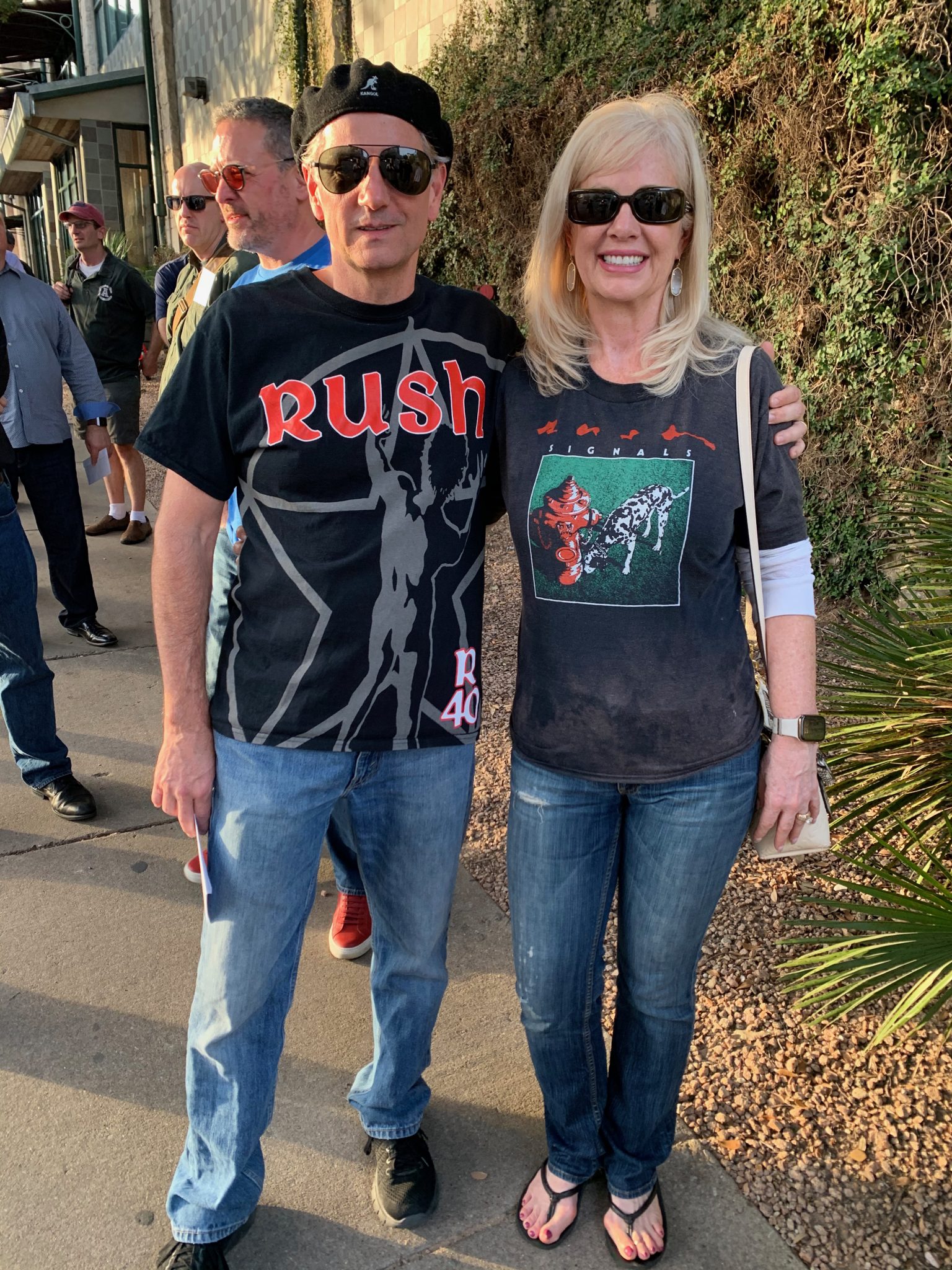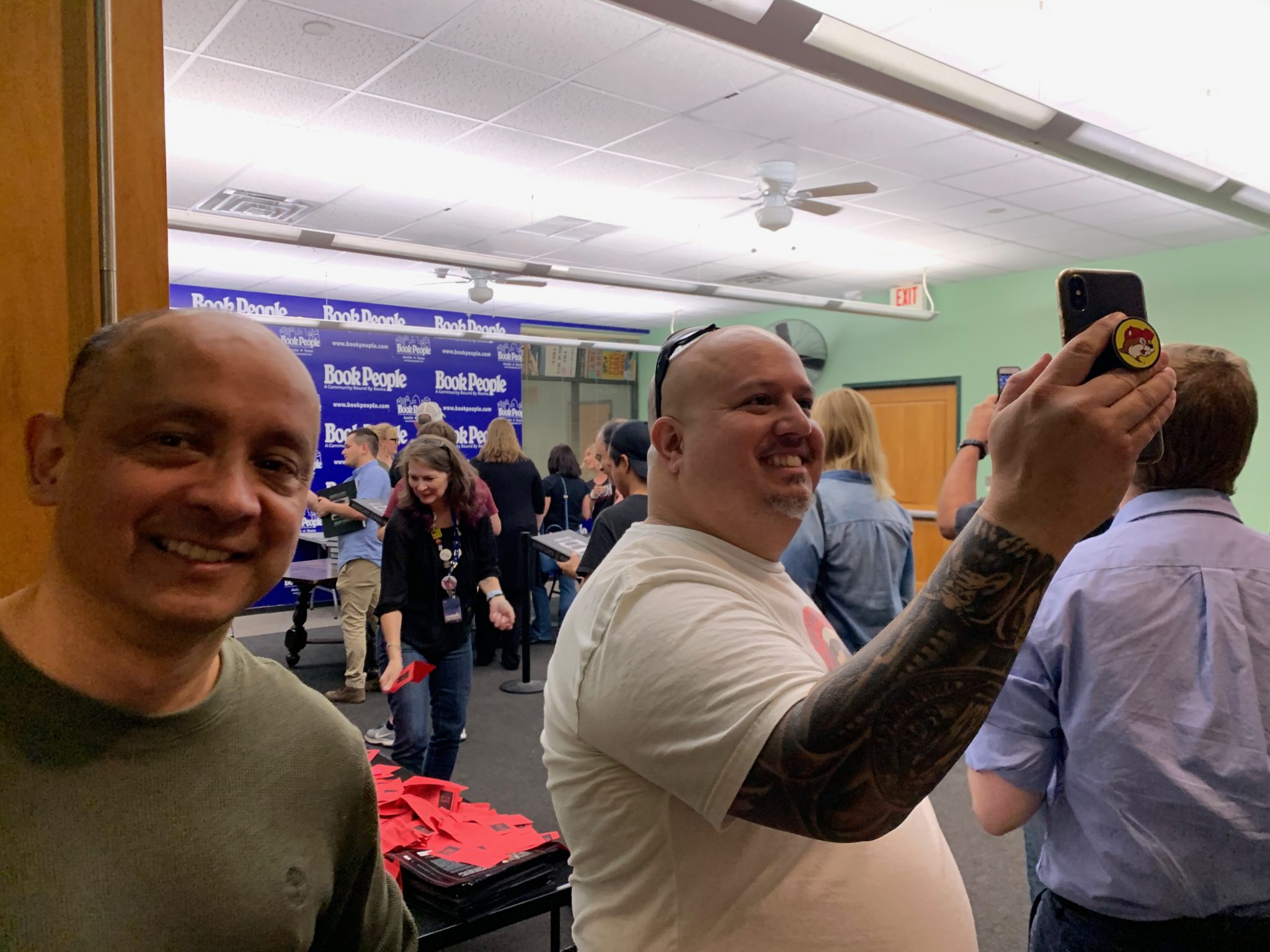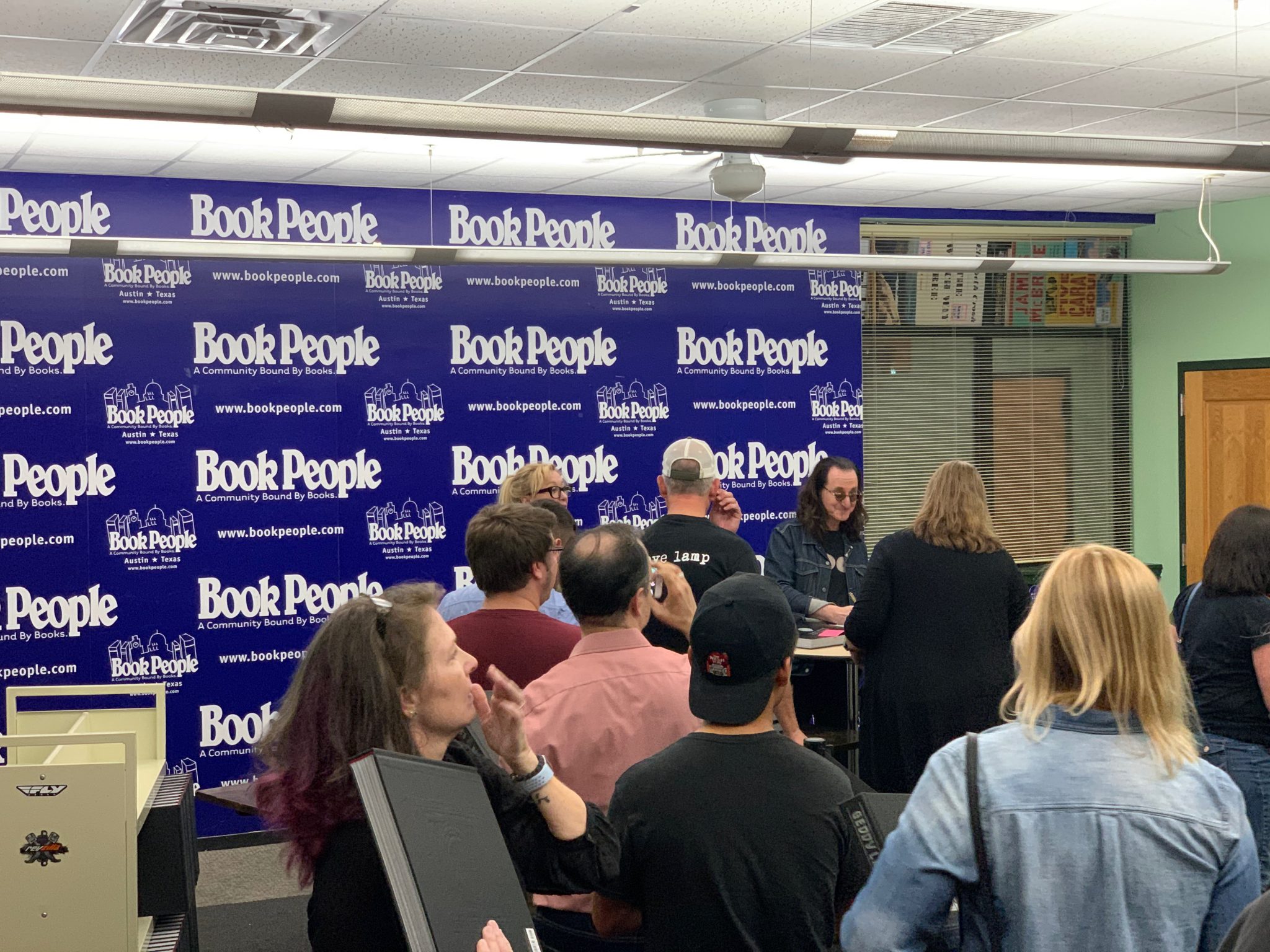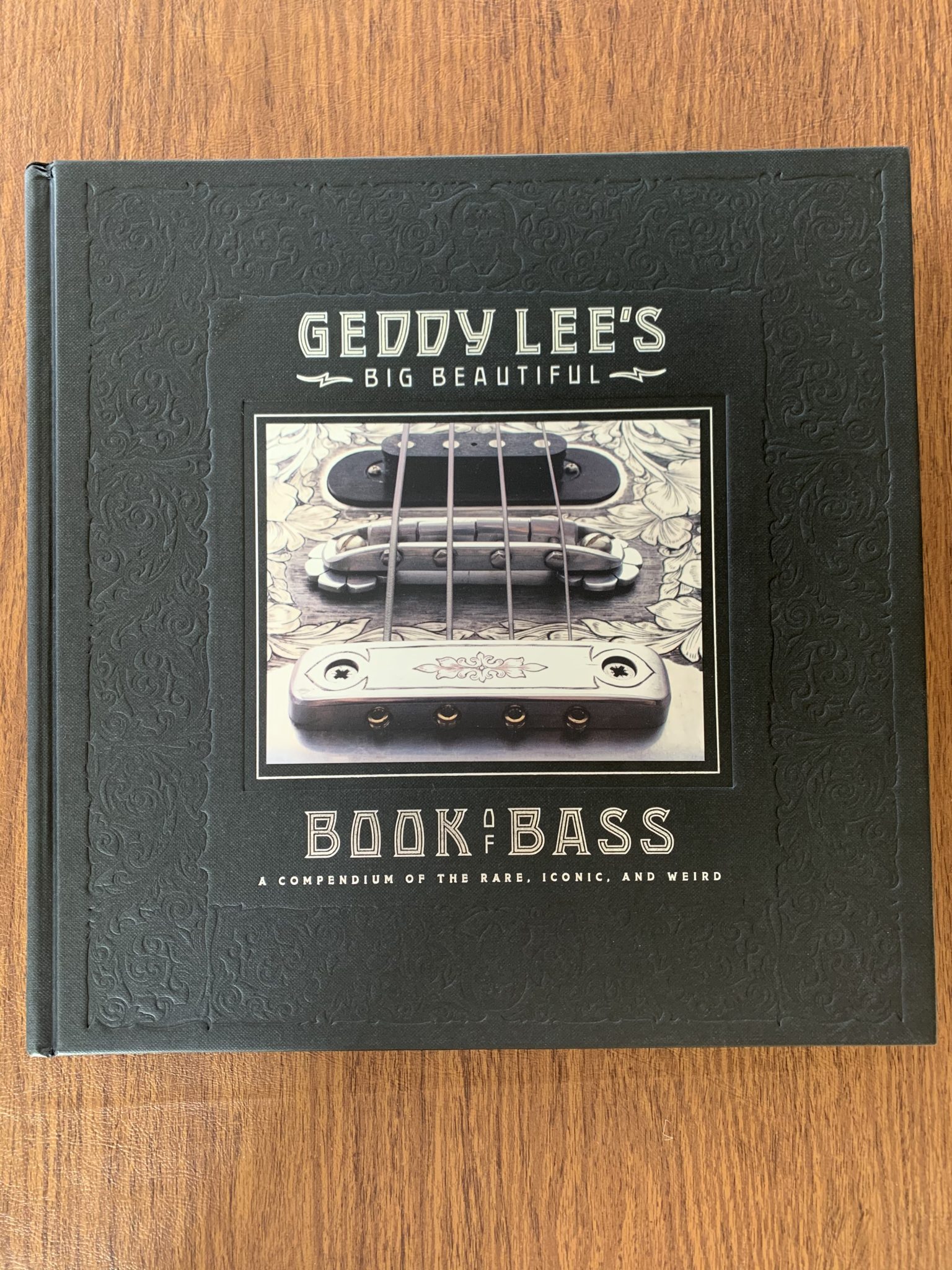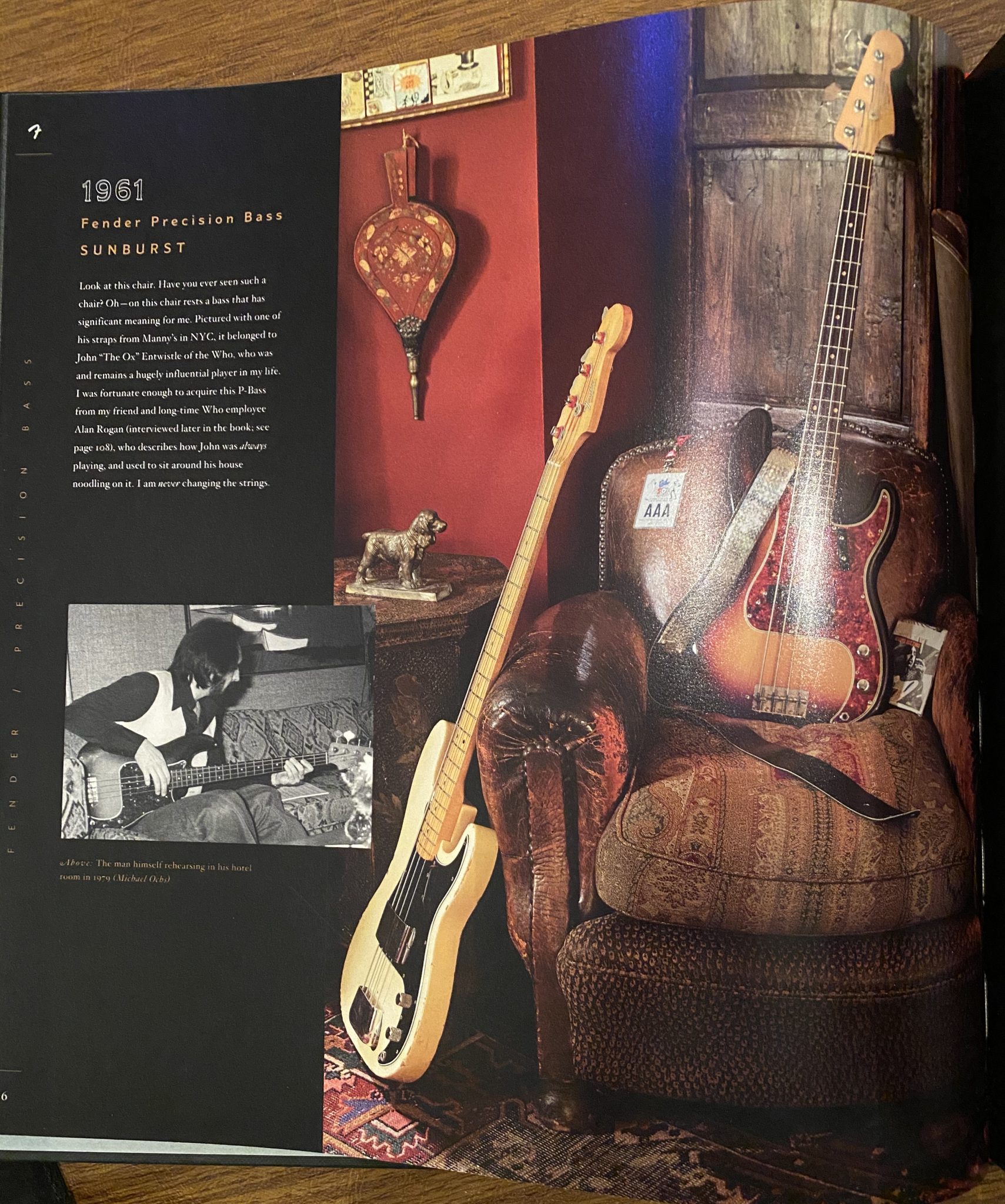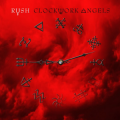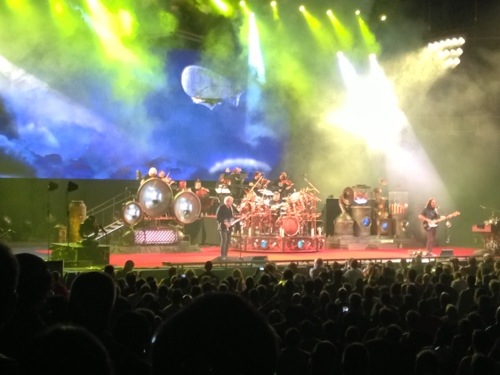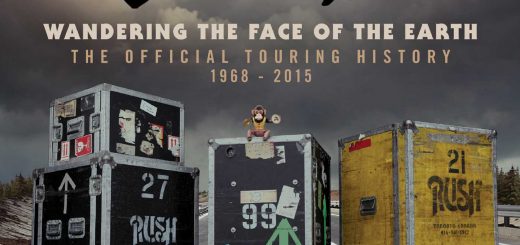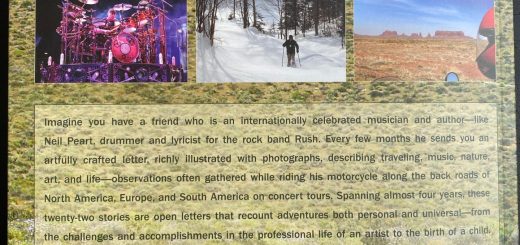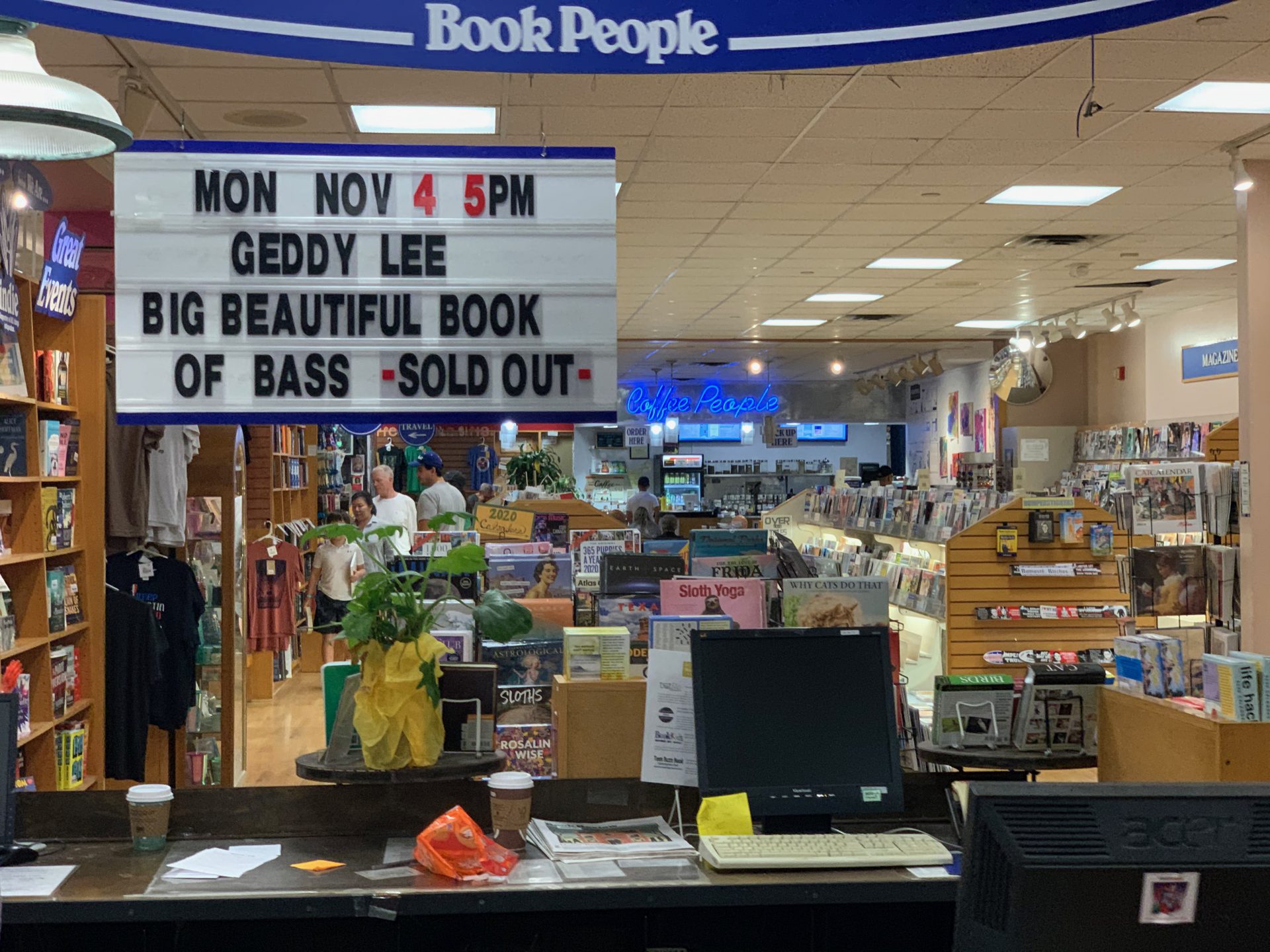Geddy Lee – book signing and notes on The Big Beautiful Book of Bass
Originally the title of this article was to be “Geddy Lee came to town and fist bumped me”. And that did happen (photographic evidence can be seen on this page). I hadn’t planned on buying a big ole coffee table book when it first came out (downsizing is not conducive to collecting), and did so to get a signature and a fist bump.
But now that I’ve seen it, now that I’ve read it cover to cover (which is one reason why this article is coming out so long after the actual signing) – I really dig it. It has history, it has interviews with some cool people in the rock and roll world…and, of course, it has a LOT of BASS. The fist bump and brief conversation with Geddy was amazingly cool…and the book is as well.
Since this article is long, below are links to the different sections if readers would prefer to skip around.
Geddy Lee Book Signing and Fist Bump
Geddy Lee had been doing a random tour of the U.S. and Canada, and he came to Bookpeople, the wonderful indie bookstore in Austin, on November 4, 2019. The book signing was schedule to start at 5pm. We arrived a little over an hour early to find the line already around the building. For those readers familiar with Bookpeople, this is on the 6th street side, behind the entrance.
Like many, my lovely wife and I were dressed up in our Rush finest. She got more comments on her vintage shirt that I got on mine!
Once the line started moving, it moved pretty quickly. When we got to the store entrance we were told that since we only had one voucher that my wife could not go up with me and take photos. According the Bookpeople gent at the foot of the stairs, several people had tried to rush past him (pun intended) without vouchers (which were sold out). Luckily, the two gents in front of us, Salil and Bill, agreed that we’d all take photos and share. That’s them in the photo below as we entered the room where Geddy was signing.
Bookpeople had sold 500 copies, and, as mentioned had sold out of vouchers. There were a lot of books being handed out. Some of the stacks can be seen in this photo…and, oh yeah, there’s Ged!
Geddy appeared to be enjoying himself. He chatted (briefly) with everyone that I saw in the line, smiling most of the time. I heard from some of the Bookpeople folks (who were great, as always) that people had tried to get him to sign their instruments, sing them songs…all manner of requests.
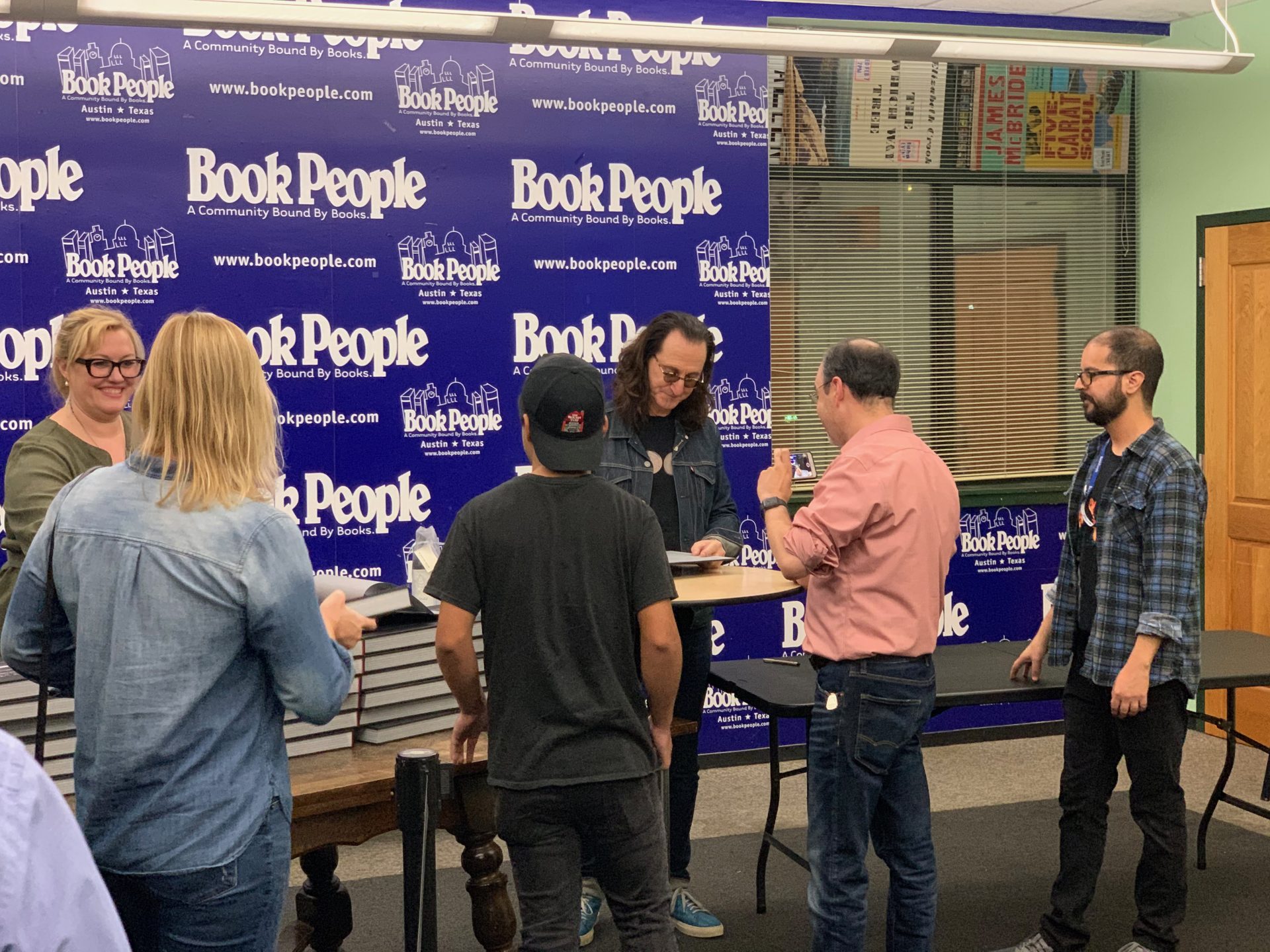
I just had the following conversation with him:
“So, now that you and Neil both have books out, is Alex next?”
He looked up at me from signing my book and laughed.
“Not a chance, Larry….not a chance.”
Actual quote as I remember it…really!
That, the signature, the fist bump, and, as I found out a lot later, the beautiful book it self, were worth waiting in line for.
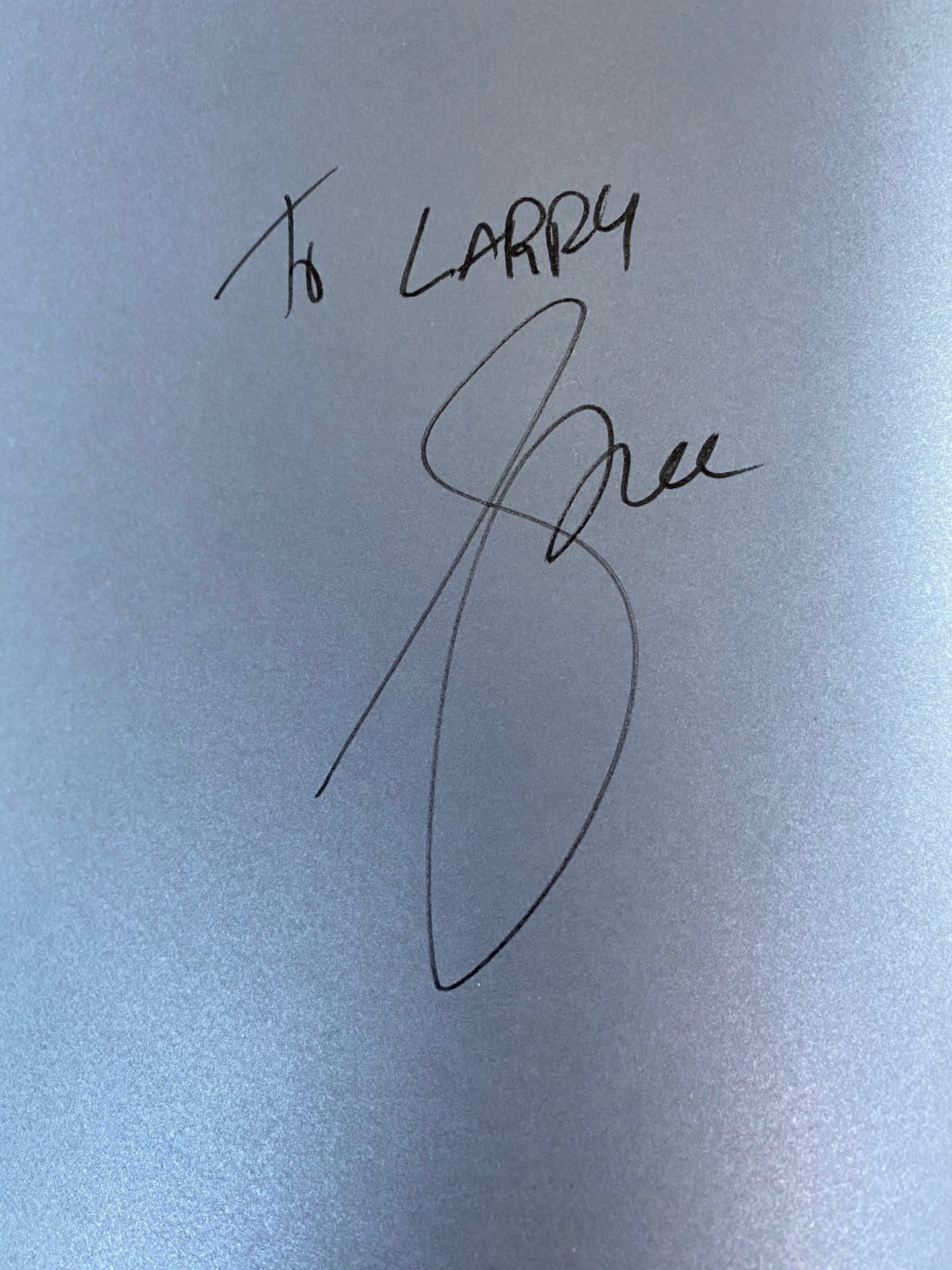
And finally, video proof of the first bump! Thanks to Bill for capturing this!
The Big Beautiful Book of Bass
The book has a very descriptive title. It is BIG – my wife keeps worrying that the weight of it will break our glass coffee table. And it is indeed a beautiful book – the photos inside are amazingly detailed and very well done. Who knew that pictures of frets, necks, pickups and disassembled basses could be so photogenic? Geddy Lee knew, of course! The photos are by Richard Sibbald – you can see some of them and his other works at his website.
I’ve really taken my time reading this book, and have gone back and forth over different sections. The book signing was a year ago – November 4, 2019; Neil passed away January 7; to understate it, a lot has happened.
I’ve actually had a bass in my hands before (very briefly) and played a bit (like a lot of people in high school or college bands) but I am not a bass player. The reader does not need to be one to appreciate this book – it has art, history, entrepreneurs, musicians from jazz and rock – and, of course, a lot of Rush.
What follows are notes from my read-through(s) of this book – but like the Rush “Wandering the Face of the World” tour book (notes here) one can’t help but relate the book to one’s own experience. This is a bit stream of consciousness but hopefully informative and enjoyable. I cannot recommend this book enough, and not just to fans of the greatest power trio in the history of the world (IMHO)!
Introduction
As a wife-described “book hoarder” this is my favorite quote from the introduction:
Allow me to take a moment here to explain something key to my personality. Once I turn my gaze to a thing with any degree of interest, I become curious, and feel compelled to research it. Curiosity turns into “fascination,” which begets even deeper “engagement, and then, uh-oh, it’s a full blown obsession. And I’m, like, Really? Again? (pg 7)
The Interviews
These interviews are spread throughout the bass manufacture chapters, but I’ve collected them here. The photos included with each interview show Geddy and each of these musician/collectors like kids in a candy store, playing basses and talking shop.
- Jeff Tweedy (Wilco) (page 52)
- There is a photo on page 55 of some of Jeff’s collection – a bass from Czechoslovakia, a Soviet-Bulgaria bass from the 1960s, a Maton Teardrop and others.
- Alan Rogan (guitar tech, blues bassist, collector) (page 109)
- Alan worked for Pete Townsend and the Who. He set up the sale of John Entwistle’s collection for the family after John passed.
- John Paul Jones (Led Zeppelin, Them Crooked Vultures) (page 124)
- This last interview in the Fender section has some great history – Ged and JPJ talk about Jack Bruce and his EB-3 ( a great bridge to the Gibson section of the book), Charles Mingus, Andy White (“the Scottish drummer on ‘Love Me Do’ because they didn’t trust Ringo, he was too new”). And, of course, bass. The photo of these two together from the book is on the photographer’s website here.
- Adam Clayton (U2) (page 172)
What I would like to do, but I’m too disorganized, before all the punk bands get too old and die, is talk to them about buying their basses, the ones I grew up with them playing. Otherwise they’re not going to be held together as a collection. But you know what it’s like, asking about someone’s main instrument that way. You’d feel like you’re robbing their first child.
Adam Clayton in Geddy Lee’s Big Beautiful Book of Bass, pg. 172
- Ken Collins (owner of the legendary Gibson Explorer Bass) (page 200)
For more information on this history of this instrument, check out Ken Collins’ Explorer bass website
Geddy Lee’s Big Beautiful Book of Bass, pg. 203
- Robert Trujillo (Metallica, Suicidal Tendencies) (page 252)
- There’s a large section of this interview that talks about Trujillo’s relationship with Jaco Pastorius, his bass of doom and the recovery of the lost bass. Trujillo wrote and produced the film about Jaco. Gotta go watch it now, be right back.
- Bill Wyman (Rolling Stones)
- Wyman made his own fretless electric bass in 1961 (“the first-ever..”) and used it on every Stones album up to 1975. A photo of this bass is on page 312.
- Small hands is why Bill Wyman says he held his bass upright when he played.
- Les Claypool (Primus)
- My brother and I were scheduled to go see Primus here in town in April. They were going to play the entire Farewell to Kings album as a tribute to Neil. But this thing called a pandemic scorched our plans, as well as that tour.
- Les is a fanboy like all of us, he talked about his bass with Geddy’s autograph on it. I’ve got this book with Ged’s autograph, so maybe a bass is next!
- Bob Daisley (Rainbow)
- One of the many reasons I took my time with this book is that it always reminded me of albums I had. I went back through my old Ritchie Blackmore and Rainbow records as I was reading this interview.
Bass Manufacturers and History
This is the majority of the book, and goes through five manufacturers with amazing photos of the instruments from each in Geddy’s extensive collection.
Fender
Quote on the page with the 1953 Fender Precision Bass
Wine geeks like me look for vintages from their birth year, so naturally I wanted the same in a bass. Now you know how effin’ old I am. (pg. 20)
In Geddy’s collection is a 1961 Sunburst Precision Bass that was played by John Entwistle of The Who. (pg. 36)
There’s a paragraph on the “CBS Takeover”, describing the acquisition of Fender by CBS in February 1965. The increased production, partially brought on by Beatlemania and everyone wanting an instrument, brought mass production into the industry. The last line in the paragraph states:
“Although some terrific instruments were products throughout the 1960s, it’s the guitars and basses from the early period – due to their craftsman ship and enduring tone quality – that are increasingly desired by collectors and players around the world.”
Geddy Lee’s Big Beautiful Book of Bass, pg. 44
Geddy talks about transitioning to the Fender Jazz Bass, first starting on ‘Tom Sawyer’ and then making it his number one bass on the Counterparts album (pg. 57)
All through this section (and the book) there are boxed sections called “A Collector’s Tale” where Geddy will tell how he came to be in possession of a particular bass. These sections are music history in and of themselves.
On page 71, there is a pic of Geddy with a 1962 Fender Jazz Fiesta Red. The caption says it was from the last song of the R40 concert, “Working Man” (my favorite song). The photo credit is for Neil Peart! On the next page there’s a Form Green ’62 that he played on “Headlong Flight” and “Far Cry” and a few pages further in there are pictures of the Lake Placid Blue bass he played on “Subdivisions.” Man, this book is really just pure music history!
Gibson and Epiphone
One of my earliest and deepest influences was Jack Bruce, and the man who proudly wrecked havoc on his EB-3 remains a hero of mine. I remember, like it was yesterday, seeing Cream at Massey Hall in Toronto on June 5, 1968, watching him grind and wind his way through those blues-based songs with that great combo of bottom-end boom and distorted Marshall amp fuzz. He was a virtuoso of complexity, yet bluesy and melodic. I loved the way he sounded in the context of that band; in that hot moment, he was everything to me.
Geddy Lee’s Big Beautiful Book of Bass, pg. 130
There is a great photo of Leslie West and Felix Pappalardi of Mountain, with Pappalardi playing a 1953 Gibson EB (pg. 134).
Photo of a herd of cherry Gibson EB-3s in front of a fireplace with mounted horns (see it here on the photographer’s web site). The book features cherry EB-3s from 1960 – 1965.
The Epiphone section starts on page 150 with a description of the differences between Epiphone and Gibson and a short history.
Gibson-Epiphone Short Scale Hollow Body section starts on page 157. There’s a gorgeous black 1966 Gibson EB-2 Custom on page 166.
The Gibson Thunderbird section, which starts on page 176, has a photo of Pete Way of UFO who passed away recently (August 2020). I saw UFO and Rush in San Antonio many times.
Geddy played a T-bird in the R40 tour on “Animate” and “How It Is”. A picture of Geddy playing that bass is on page 198 (Polaris White Gibson Thunderbird II).
Rickenbacker
There’s a great quote from Chris Squire of Yes at the start of this section:
I think the first three Rickenbacker basses were imported around 1964. Pete Quaife, the bassist for the Kinks bought one. Then John Entwistle from The Who bought one. As for the third one, I asked the manager of the store if I could get an employee discount. He said I could, and so I picked up that one.
Chris Squire, Geddy Lee’s Big Beautiful Book of Bass, pg. 207
There’s a 1968 Burgundyglo Rickenbacker 4001 on page 221 that Geddy says he took on tour in 2015 and played on the “Camera Eye”.
I’m sure there are a lot more Easter eggs in this book than what I’ve found – but I like the seemingly casual placement of the sheet music to “Witch Hunt” behind the bass on pages 228-229.

The double neck from Xanadu!!! 1975 4080/12 Jetglo Doubleneck on page 230.
Höfner
The photo that opens the Höfner section is my favorite of the entire book. It captures a Höfner bass with amps and a plethora of Rush paraphernalia. I looked for the photo on the photographer’s, Richard Sibbald, web site, but couldn’t find it. My photo of the that page of the book is below.
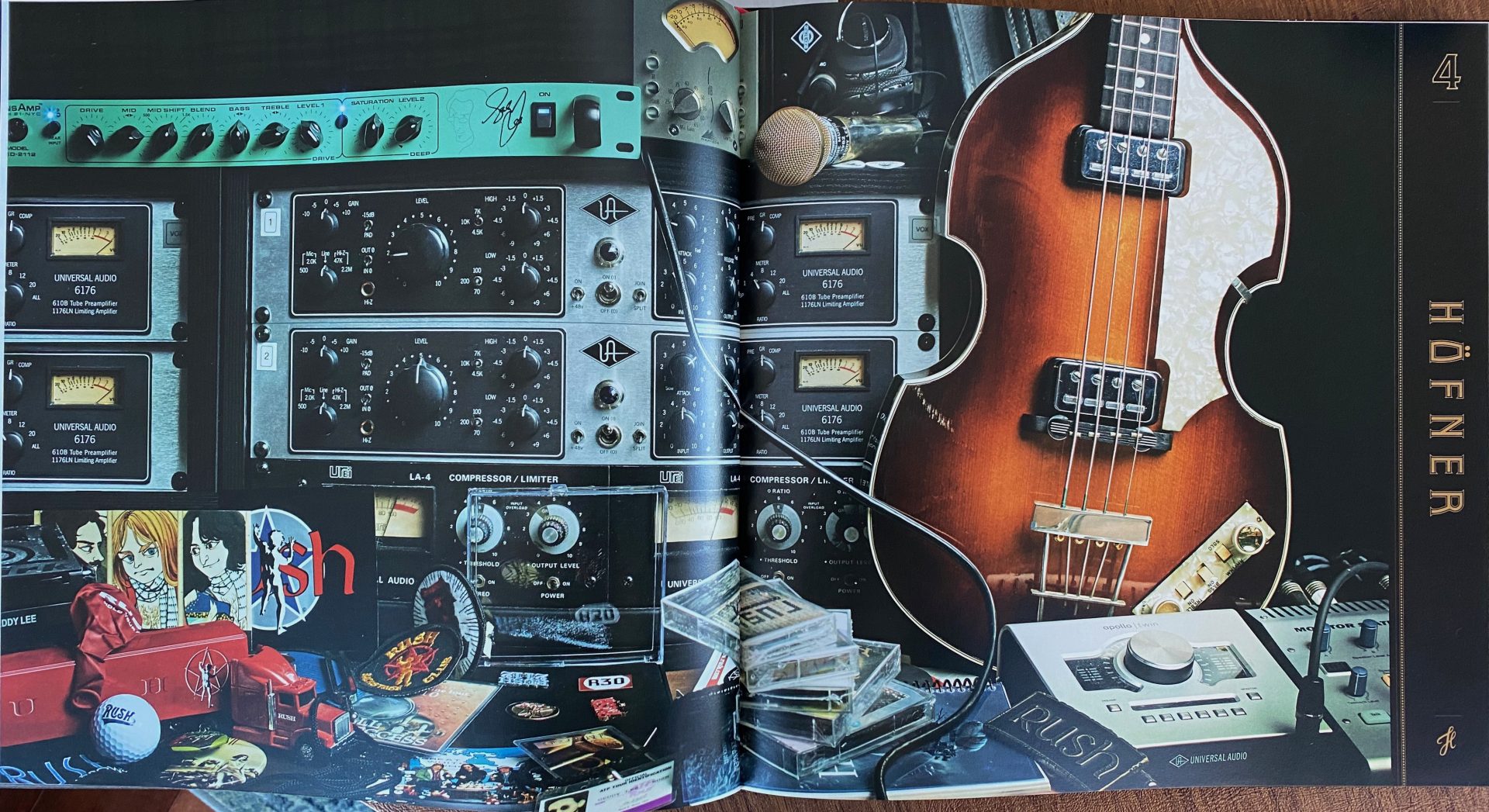
It could be said that if it weren’t for the Beatles, Höfners would have languished in obscurity, but the more time I’ve spent playing them, the more my respect for their beautiful craftsmanship (especially in the early years) has grown.
Geddy Lee’s Big Beautiful Book of Bass, pg. 259
Geddy talks about buying a red 1961 set-neck solid bass during rehearsals in Los Angeles for the R40 tour, and playing it on “What You’re Doing.” (pg. 259). That bass is pictured and described on page 276.
An original 1961 Höfner 500/1 Cavern bass from Ged’s collection is shown on page 264, along with the description of what it is (Paul McCartney played one) with specs and a warning about fakes. The next few pages talk about different models of the 500/1 and how to tell them apart from the rare “Cavern” bass. More Beatles mention with the 1959 500/5 Sunburst, referred to as the “Sutcliffe Bass” after Stu Sutcliffe who played bass with the Silver Beatles in the early days.
Somehow a guitar has invaded the Big Book of Bass – a 1960 Höfner Fledermaus guitar that looks like a bat.
Ampeg
From this player’s perspective, they’re somewhat unwieldy, and for my music, their ton can be a challenge, but as a collector and appreciator of the unusual, I love their eccentricity and find them hard to resists.
Geddy Lee’s Big Beautiful Book of Bass, pg. 293
There are pictures and descriptions of two Dan Armstrong Ampegs, including a see-through made of Plexiglass on pages 306-309.
Around the World in 80 Basses
As a amateur historian (currently on the board of the Texas State Historical Association) and book collector, though my collections pale in comparisons to Geddy’s bass, wine and other assorted objects, this quote resonates. Many times it’s more about the history of a thing, its story, than about the thing itself.
As I mentioned earlier in the book, I’ve always seen collecting as a window to history and culture, basses have been no exception
Geddy Lee’s Big Beautiful Book of Bass, pg. 317
Pages 318 – 372 feature basses from manufacturers most people (me certainly) have not heard of (though the Danelectro brand rings a bell – there’s a photo of Jimmy Page of Led Zeppelin with one on page 322). The breadth and depth of Geddy’s collection is astounding – where does he keep all of these instruments?
There are A LOT of sparkly basses on these pages from Italy and from Sweden (page 342-346) including a green sparkle “Batman” bass. There’s also a Hagstrom Swedish bass on page 348 like Noel Redding played with Jimi Hendrix.
I did not realize there is a fold-out page in this big beautiful book, on page 370. It is reserved to show the beautiful art work on a Tony Zemaitis bass. Geddy’s collection has two – a 1983 “Geisha Girl” and a 1992 “Daisley”. These truly are works of art – I’d be afraid to touch them, much less try to play them.
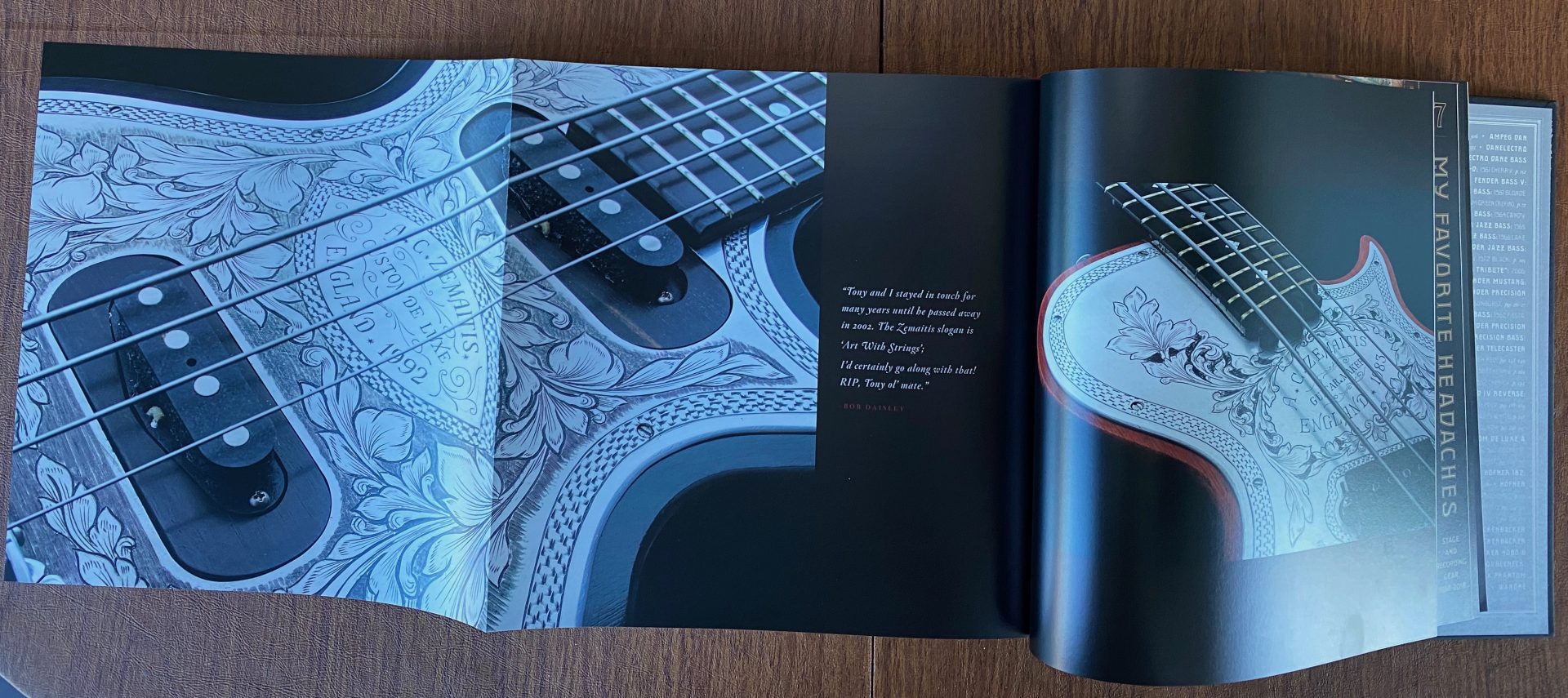
My Favorite Headaches – Stage and Recording Gear, 1968 – 2018
My favorite chapter (named after Geddy’s solo album, or life on the road or something else?) in the book is this section that walks through what Geddy Lee was playing throughout the years. As noted previously, Geddy notes bass by bass if he played them on particular songs on tours, but this chronology pulls it all together. I’ve put them in a table below in the order they appear (which is noted as the order they were used). One day when spare time permits, it would be fun to add in the instruments that Alex and Neil played during the same period – but I’ll bet that already exists on the internet somewhere.
| Maker | Bass | Used On | Pg |
| Rickenbacker | 1973 4001 JETGLO | tours through 1977 every album from Fly By Night to A Farewell to Kings | 382-383 |
| Rickenbacker | 1977 4001 JETGLO | 1977 – 1985 (with the 1973 version) Hemispheres, Permanent Waves, Moving Pictures, Exit Stage Left, Signals and parts of Grace Under Pressure | 384-385 |
| Rickenbacker | 1976 4080/12 JETGLO DOUBLENECK | none mentioned | 386-387 |
| Rickenbacker | 1979 4080/6 WHITE DOUBLENECK | used to play bass and rhythm guitar parts for “A Passage to Bangkok” | 388-389 |
| Fender | 1968 Precision “Space Bass” | “In the Mood” in the late 1970s | 390-391 |
| Steinberger | 1980s XL2 MK I | parts of Grace Under Pressure album and tour | 392 |
| Wal | 1985 MK I 1990 MK II | Power Windows, Hold Your Fire, A Show of Hands, Presto and Roll the Bones | 393-394 |
| Wal | 1986 MK II Five String | Hold Your Fire tour for “Lock and Key“ | 395 |
| Fender | 1972 Jazz Bass | “Tom Sawyer” and “Vital Signs”, on Counterparts, Test for Echo, Vapor Trails, Snakes and Arrows, Clockwork Angels and all live recordings since then | 396-397 |
| Fender | 1972 Jazz Bass SUNBURST 1974 Jazz Bass BLACK | in studio and on tour since the late 1990s | 398 |
| Fender | 1997 Jazz Bass TRANS RED 2006 Jazz Bass Fretless “Jaco Tribute” | used the 1997 on at least one song on every album and tour since the late 1990s (including “2112” live). used the “Jaco” on “Malignant Narcissism” on Snakes and Arrows tour and album | 399 |
There is one additional fold-out page at the end of this section that shows the basses on tour.
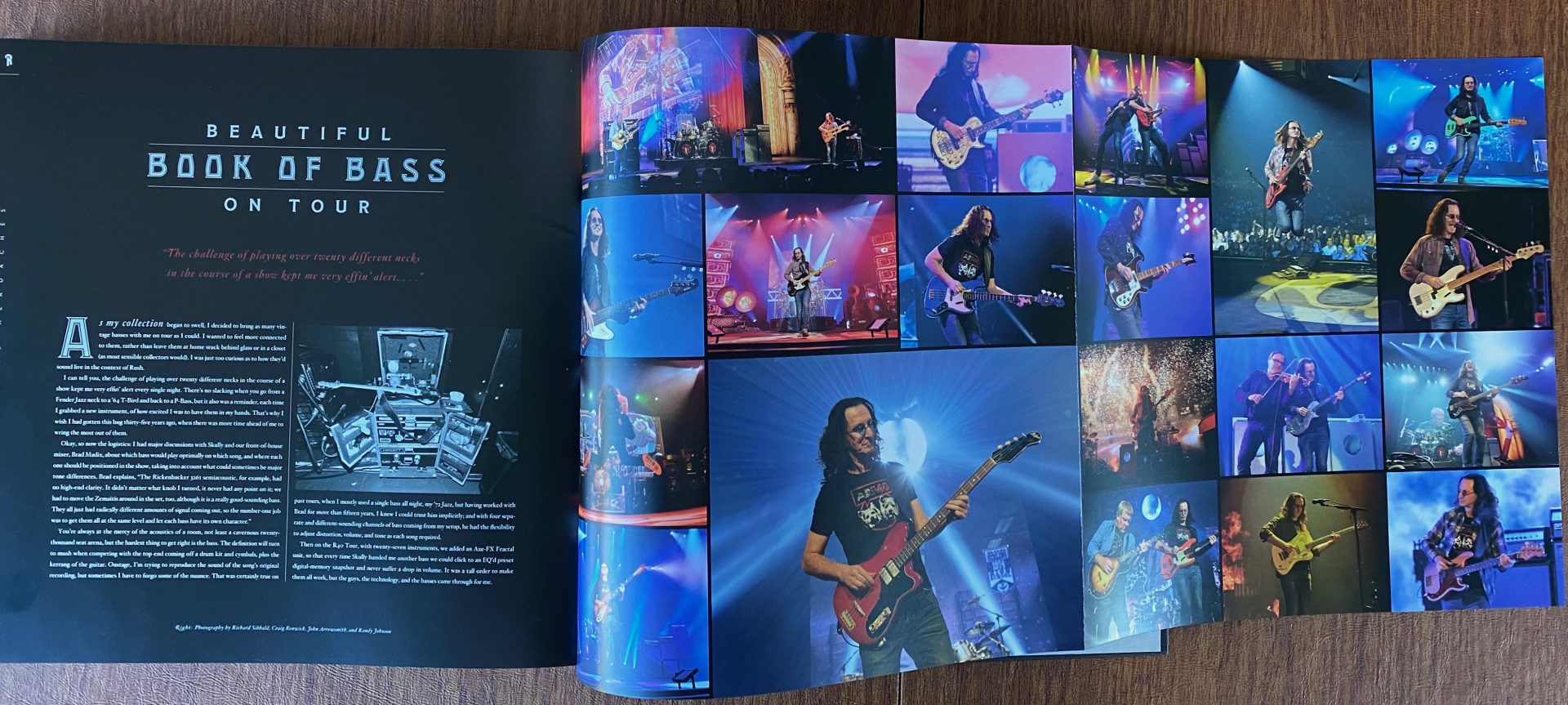
This article would not be complete without the photo below. Many thanks, Geddy, for the signature, the fist bump, the brief conversation, the book and the music over the years.
